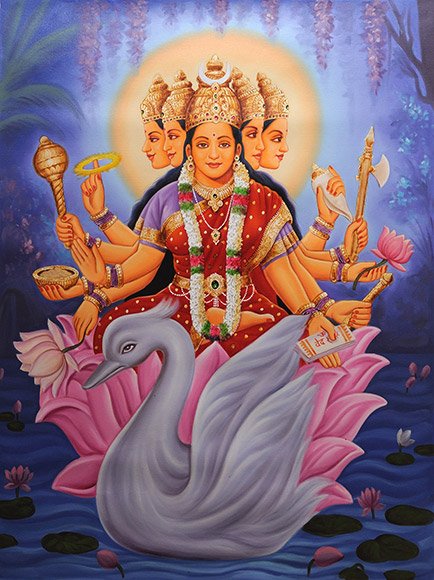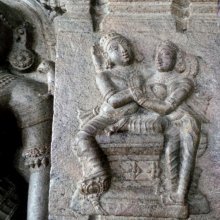Aravinda, Aravimda: 23 definitions
Introduction:
Aravinda means something in Hinduism, Sanskrit, Jainism, Prakrit, Buddhism, Pali, Marathi, Hindi, biology. If you want to know the exact meaning, history, etymology or English translation of this term then check out the descriptions on this page. Add your comment or reference to a book if you want to contribute to this summary article.
Images (photo gallery)
In Hinduism
Chandas (prosody, study of Sanskrit metres)
Source: Shodhganga: a concise history of Sanskrit Chanda literatureAravinda (अरविन्द) is the name of a Sanskrit metre (chandas) to which Hemacandra (1088-1173 C.E.) assigned the alternative name of Kala-bhāṣiṇī in his auto-commentary on the second chapter of the Chandonuśāsana. Hemacandra gives these alternative names for the metres by other authorities (like Bharata), even though the number of gaṇas or letters do not differ.

Chandas (छन्दस्) refers to Sanskrit prosody and represents one of the six Vedangas (auxiliary disciplines belonging to the study of the Vedas). The science of prosody (chandas-shastra) focusses on the study of the poetic meters such as the commonly known twenty-six metres mentioned by Pingalas.
Shaktism (Shakta philosophy)
Source: Brill: Śaivism and the Tantric Traditions (shaktism)Aravindā (अरविन्दा) [=aravindī?] refers to “beautiful lotuses”, according to the King Vatsarāja’s Pūjāstuti called the Kāmasiddhistuti (also Vāmakeśvarīstuti), guiding one through the worship of the Goddess Nityā.—Accordingly, “[...] She is elegantly seated on a lofty couch studded with jewels, furnished with seats and pillows, and decorated with a canopy of pearls. Her face is a fully developed lotus. She has a row of chowries being shaken around her, and her beaming lotus-face surpasses beautiful lotuses (aravindī). [...]”.

Shakta (शाक्त, śākta) or Shaktism (śāktism) represents a tradition of Hinduism where the Goddess (Devi) is revered and worshipped. Shakta literature includes a range of scriptures, including various Agamas and Tantras, although its roots may be traced back to the Vedas.
Yoga (school of philosophy)
Source: Brill: Śaivism and the Tantric Traditions (yoga)Aravinda (अरविन्द) refers to a “lotus”, according to the Amṛtasiddhi, a 12th-century text belonging to the Haṭhayoga textual tradition.—Accordingly, “At the navel is a white lotus (śubhra-aravinda). On top of that is the spotless orb of the sun. In the middle of that, at the triple pathway, is she who is the sole essence of saṃsāra [and] the creator of the three worlds, who arises on the path of dharma, who has three bodies [and] who is lauded as Chinnamastā, “she whose head is cut.” I worship her, she who has the form of knowledge, who removes the danger of death, the Yoginī, the seal of Yoga”.

Yoga is originally considered a branch of Hindu philosophy (astika), but both ancient and modern Yoga combine the physical, mental and spiritual. Yoga teaches various physical techniques also known as āsanas (postures), used for various purposes (eg., meditation, contemplation, relaxation).
In Jainism
General definition (in Jainism)
Source: archive.org: TrisastisalakapurusacaritraAravinda (अरविन्द) is the son of Ara-nātha, according to chapter 6.2 [aranātha-caritra] of Hemacandra’s 11th century Triṣaṣṭiśalākāpuruṣacaritra: an ancient Sanskrit epic poem narrating the history and legends of sixty-three illustrious persons in Jainism.
Accordingly:—“[...] Ara he was told by the Lokāntikas, ‘Found a congregation’. After giving gifts for a year, he gave the kingdom to his son Aravinda and went to Sahasrāmravaṇa in the palanquin Vaijayantī. [...]”.
Source: The University of Sydney: A study of the Twelve ReflectionsAravinda (अरविन्द) (Cf. Aravindāsana) refers to the “lotus (posture)”, according to the 11th century Jñānārṇava, a treatise on Jain Yoga in roughly 2200 Sanskrit verses composed by Śubhacandra.—Accordingly, “On a flat piece of wood or stone, on the ground or on sandy soil, the wise [person] should adopt a stable posture for the accomplishment of absorption. Thus, sitting cross-legged, sitting half cross-legged, thunderbolt, hero posture and the previously mentioned pleasant and lotus (aravinda-āsana—sukhāravindapūrve) [postures] as well as abandonment of the body is highly thought of. [...]”.

Jainism is an Indian religion of Dharma whose doctrine revolves around harmlessness (ahimsa) towards every living being. The two major branches (Digambara and Svetambara) of Jainism stimulate self-control (or, shramana, ‘self-reliance’) and spiritual development through a path of peace for the soul to progess to the ultimate goal.
Biology (plants and animals)
Source: Google Books: CRC World Dictionary (Regional names)Aravinda in India is the name of a plant defined with Nymphaea rubra in various botanical sources. This page contains potential references in Ayurveda, modern medicine, and other folk traditions or local practices It has the synonym Nymphaea rubra Roxb. ex Salisb..
Example references for further research on medicinal uses or toxicity (see latin names for full list):
· Cytologia (1980)
If you are looking for specific details regarding Aravinda, for example extract dosage, diet and recipes, chemical composition, pregnancy safety, side effects, health benefits, have a look at these references.

This sections includes definitions from the five kingdoms of living things: Animals, Plants, Fungi, Protists and Monera. It will include both the official binomial nomenclature (scientific names usually in Latin) as well as regional spellings and variants.
Languages of India and abroad
Pali-English dictionary
Source: BuddhaSasana: Concise Pali-English Dictionaryaravinda : (nt.) a lotus.
Source: Sutta: The Pali Text Society's Pali-English DictionaryAravinda, (ara + vinda (?) Halāyudha gives as Sk. aravinda nt. ) a lotus, Nymphaea Nelumbo Dāvs. V, 62. (Page 76)

Pali is the language of the Tipiṭaka, which is the sacred canon of Theravāda Buddhism and contains much of the Buddha’s speech. Closeley related to Sanskrit, both languages are used interchangeably between religions.
Marathi-English dictionary
Source: DDSA: The Molesworth Marathi and English Dictionaryaravinda (अरविंद).—n S A lotus. Ex. rāmācēṃ vadanāravinda || Also tayācēṃ jēṃ caraṇāravinda || tēthēṃ śrīdhara ananya mi- linda || divya āmōda sēvitasē ||
Source: DDSA: The Aryabhusan school dictionary, Marathi-Englisharavinda (अरविंद).—n A lotus.
Marathi is an Indo-European language having over 70 million native speakers people in (predominantly) Maharashtra India. Marathi, like many other Indo-Aryan languages, evolved from early forms of Prakrit, which itself is a subset of Sanskrit, one of the most ancient languages of the world.
Sanskrit dictionary
Source: DDSA: The practical Sanskrit-English dictionaryAravinda (अरविन्द).—[arān cakrāṅgānīva patrāṇi vindate vind śa P. III.1.138. Vārt.]
1) A lotus (Nymphea Stellata) (it is one of the 5 arrows of Cupid; see under pañcabāṇa); शक्यमरविन्दसुरभिः (śakyamaravindasurabhiḥ) Ś.3.6. It is a sun lotus; cf. सूर्यंशुभिर्भिन्न- मिवारविन्दम् (sūryaṃśubhirbhinna- mivāravindam) Kumārasambhava 1.32; स्थल°, चरण°, मुख° (sthala°, caraṇa°, mukha°) &c.
2) Also a red or blue lotus.
-daḥ 1 The (Indian) crane.
2) Copper.
Derivable forms: aravindam (अरविन्दम्).
Source: Cologne Digital Sanskrit Dictionaries: Shabda-Sagara Sanskrit-English DictionaryAravinda (अरविन्द).—n.
(-ndaṃ) 1. lotus, (Nymphæa nelumbo.) 2. Copper. E. ara quickly, and vinda to obtain, śa affix; with reference to the lotus, as of quick growth.
Source: Cologne Digital Sanskrit Dictionaries: Benfey Sanskrit-English DictionaryAravinda (अरविन्द).—n. A lotus, [Raghuvaṃśa, (ed. Stenzler.)] 1, 43.
Source: Cologne Digital Sanskrit Dictionaries: Cappeller Sanskrit-English DictionaryAravinda (अरविन्द).—[neuter] day-lotus; [abstract] tva [neuter]
Source: Cologne Digital Sanskrit Dictionaries: Aufrecht Catalogus CatalogorumAravinda (अरविन्द) as mentioned in Aufrecht’s Catalogus Catalogorum:—poet. [Sūktikarṇāmṛta by Śrīdharadāsa]
Source: Cologne Digital Sanskrit Dictionaries: Monier-Williams Sanskrit-English Dictionary1) Aravinda (अरविन्द):—n. ([from] ara and vinda, [Pāṇini 3-1, 138; Kāśikā-vṛtti]), a lotus, Nelumbium Speciosum or Nymphaea Nelumbo, [Śākaṭāyana] etc.
2) m. the Indian crane, [cf. Lexicographers, esp. such as amarasiṃha, halāyudha, hemacandra, etc.]
3) copper, [cf. Lexicographers, esp. such as amarasiṃha, halāyudha, hemacandra, etc.]
Source: Cologne Digital Sanskrit Dictionaries: Yates Sanskrit-English DictionaryAravinda (अरविन्द):—[ara-vinda] (ndaṃ) 1. n. A lotus; copper.
Source: DDSA: Paia-sadda-mahannavo; a comprehensive Prakrit Hindi dictionary (S)Aravinda (अरविन्द) in the Sanskrit language is related to the Prakrit words: Araviṃda, Āraviṃda.
[Sanskrit to German]
Sanskrit, also spelled संस्कृतम् (saṃskṛtam), is an ancient language of India commonly seen as the grandmother of the Indo-European language family (even English!). Closely allied with Prakrit and Pali, Sanskrit is more exhaustive in both grammar and terms and has the most extensive collection of literature in the world, greatly surpassing its sister-languages Greek and Latin.
Hindi dictionary
Source: DDSA: A practical Hindi-English dictionaryAraviṃda (अरविंद) [Also spelled arvind]:—(nm) a lotus flower.
...
Prakrit-English dictionary
Source: DDSA: Paia-sadda-mahannavo; a comprehensive Prakrit Hindi dictionary1) Araviṃda (अरविंद) in the Prakrit language is related to the Sanskrit word: Aravinda.
2) Āraviṃda (आरविंद) also relates to the Sanskrit word: Āravinda.
Prakrit is an ancient language closely associated with both Pali and Sanskrit. Jain literature is often composed in this language or sub-dialects, such as the Agamas and their commentaries which are written in Ardhamagadhi and Maharashtri Prakrit. The earliest extant texts can be dated to as early as the 4th century BCE although core portions might be older.
Kannada-English dictionary
Source: Alar: Kannada-English corpusAraviṃda (ಅರವಿಂದ):—
1) [noun] any of various water lilies, esp. the pink or white Asian lotus (Nelumbo nucifera), used as a religious symbol in Hinduism and Buddhism; the lotus plant and its flower.
2) [noun] (pros.) name of a meter.
3) [noun] the Indian crane, a bird of the family Gruidae, of usu. large gruiform wading birds with very long legs and neck and a long, straight bill.
Kannada is a Dravidian language (as opposed to the Indo-European language family) mainly spoken in the southwestern region of India.
See also (Relevant definitions)
Starts with (+1): Aravimdabamdhu, Aravimdabhava, Aravimdagamdhi, Aravimdagarbha, Aravimdakara, Aravimdamitra, Aravimdamukhi, Aravimdanetra, Aravimdanetre, Aravimdapriya, Aravimdasakha, Aravimdasye, Aravimdavana, Aravindabha, Aravindadalaprabha, Aravindaka, Aravindaksha, Aravindanabha, Aravindanabhi, Aravindasad.
Ends with: Ambararavinda, Caranaravinda, Charanaravinda, Gaganaravinda, Kanakaravimda, Karavinda, Lilaravinda, Nagaravinda, Padaravinda, Paravinda, Shubhraravinda, Sthalaravinda, Vyomaravinda.
Full-text (+8): Aravindanabhi, Aravindini, Ravinda, Aravindadalaprabha, Aravindasad, Padaravinda, Caranaravinda, Lilaravinda, Aravindanabha, Arvind, Varivindi, Aravindaksha, Aravintappavai, Caranaravintam, Niravinda, Shriniketa, Kakanaravintam, Sthalaravinda, Aravindabha, Unnidra.
Relevant text
Search found 20 books and stories containing Aravinda, Āraviṃda, Araviṃda, Ara-vinda, Aravimda, Āravinda; (plurals include: Aravindas, Āraviṃdas, Araviṃdas, vindas, Aravimdas, Āravindas). You can also click to the full overview containing English textual excerpts. Below are direct links for the most relevant articles:
The Garuda Purana (by Manmatha Nath Dutt)
Chapter LXXXVI - Merit of performing Sraddhas at Preta Sila < [Agastya Samhita]
Chapter LXXXIII - Description of different rites < [Agastya Samhita]
Hari-bhakti-kalpa-latikā (by Sarasvati Thkura)
Trishashti Shalaka Purusha Caritra (by Helen M. Johnson)
Part 3: Second incarnation as elephant < [Chapter II - Previous births of Pārśvanātha]
Part 6: Initiation of Ara < [Chapter II - Śrī Aranāthacaritra]
Part 2: Incarnation as Marubhūti < [Chapter II - Previous births of Pārśvanātha]
Garga Samhita (English) (by Danavir Goswami)
Verse 1.8.8 < [Chapter 8 - Description of Śrī Rādhikā’s Birth]
Verse 5.5.19 < [Chapter 5 - Śrī Kṛṣṇa’s Entrance Into Mathurā]
Verse 1.11.12 < [Chapter 11 - Description of Śrī Kṛṣṇacandra’s Birth]
Sahitya-kaumudi by Baladeva Vidyabhushana (by Gaurapada Dāsa)
Text 10.46 < [Chapter 10 - Ornaments of Meaning]
Text 4.84 < [Chapter 4 - First-rate Poetry]
Text 10.1 [Upamā] < [Chapter 10 - Ornaments of Meaning]
Bhakti-rasamrta-sindhu (by Śrīla Rūpa Gosvāmī)
Verse 4.8.23 < [Part 8 - Compatible & Incompatible Mellows (maitrī-vaira-sthiti)]
Verse 2.1.130 < [Part 1 - Ecstatic Excitants (vibhāva)]
Verse 2.3.54 < [Part 3 - Involuntary Ecstatic Expressions (sattvika-bhāva)]
Related products

